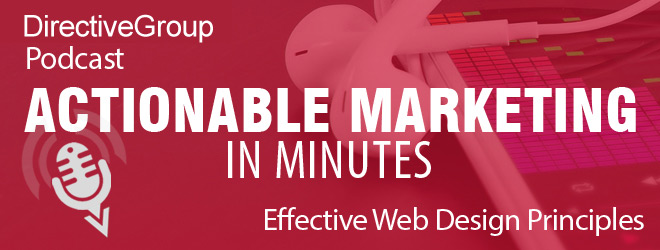In this episode of Actionable Marketing In Minutes we consider some of the most Effective Web Design Principles.
Use the player below to listen to this episode, or the download link to load it on your device for listening later. You can also find our RSS feed by clickinghere, or subscribe by email in the sidebar to the left.
Download our Marketing To Millennials eBook here!
Not able to listen? Why not read the episode transcript below:
Problem:
Your website serves as a digital business card and the quality of the web design on your site conveys the legitimacy and trustworthiness of your business. When it comes to designing a website, it is easy to get caught up only on the aesthetics. For instance, should we use light blue or dark blue in the background? Will the logo look good on the top right of the screen? What font should we choose? But besides the visual presentation, web design also involves usability, user interface, the architecture of information, site layout, and navigation ergonomics. A cohesive web design can have a positive impact on referrals, conversions and abandon rates.
Solution:
To stand out among a billion other websites, you have to follow certain design principles that act as best-practices for successful web design.
#1 Easy and Intuitive Navigation
Visitors come to your site to look for information or to complete an action, such as make a purchase. Intuitive navigation is all about getting visitors on your site to where they want to be in the fewest number of clicks possible, before they lose interest and leave.
To optimize navigation for usability and improve visual appeal, you can simplify the structure of your primary navigation and place it near the top of your page. It is important to keep the main navigation consistent throughout all the pages of your site. Also, use breadcrumbs on every page to leave a navigation trail and add a search box in your site so that visitors can search by keywords.
Lastly, remember to stick to simple clear, and exciting words for all your call-to-actions or an internal link, clearly stating where that link is leading to. Some examples might be “Buy Now” or “Let’s Get Started!”
#2 Visual Hierarchy
Visual hierarchy entails organizing and optimizing website elements so that visitors can naturally gravitate toward the most important topic, content, or block first. Our eye moves and perceives things best in a certain order. The idea is to lead visitors to first view what is most important and then move them onto the others in the most natural and logical way.
By modifying the position, color, or size of certain website elements, you can structure your site in such a way that visitors will be drawn to those elements first. Create an order of importance is by placing content, images, and videos, in such a way that the human eye first travels to the content that is most important.
Remember, a simple design is most effective so you can consider a grid-based layout where content gets divided into columns, boxes, and different sections or opt for F-pattern design to complement the natural reading behavior of your audience.
#3 Content Spacing
For your site to effectively communicate information or content with visitors clearly, you must think of content spacing. Too much content with minimal spacing can clutter your page, and put a cognitive load on the users, whereas proper spacing can make your page appear clearer. Whitespace creates a balance between readability, legibility and views.
The three aspects of web page spacing are: line spacing, white space and padding. Too little space in between lines can cause the reader to miss sentences and any bigger than half a centimeter can cause your eyes to become lost. White space can be used between and around your content to divide it up into distinct parts, thus making it simpler to process information. It also adds contrast and proportion to a page. Also, padding ensures that there is enough space between the text and the other elements on the web page to make your site readable.
Benefits:
The three principles we have touched on in this podcast – Navigation, Visual Hierarchy, & Spacing are a good starting point. But effective web design and usability ultimately depends on the preferences of your site’s visitors. So, conducting usability tests, gathering feedback about problems related to design or layout and making necessary changes based on them is what will make your web site great.
We hope you’ve found this information helpful. Please connect with us on Twitter @DirectiveGroup or on LinkedIn. Let us know what you think and what you’d like to hear about next. And if you like our podcasts please share with your networks using hashtag #actionablemarketing.
Join us for an upcoming episode where we discuss “Should You Have a Marketing Roadmap?”
Podcast: Play in new window | Download (Duration: 6:30 — ) | Embed
